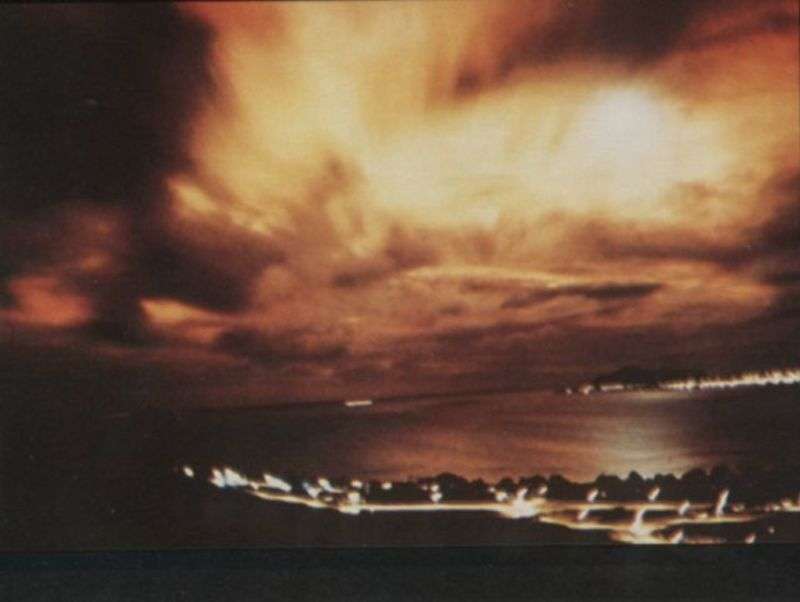
Trump signs executive order to make America greater than EMPs

On March 26, President Donald Trump signed an executive order aimed at preparing the US to withstand an electromagnetic pulse (EMP) attack. “Human-made or naturally occurring EMPs can affect large geographic areas, disrupting elements critical to the Nation’s security and economic prosperity, and could adversely affect global commerce and stability,” Trump’s order stated. “The Federal Government must foster sustainable, efficient, and cost-effective approaches to improving the Nation’s resilience to the effects of EMPs.”
The new order places two types of threats under the EMP umbrella—those caused by high-altitude nuclear explosions and those created by geomagnetic disturbances (GMDs) resulting from solar flares. In addition to mandating new risk evaluations for EMP attacks by the Department of Defense, Department of Homeland Security, and director of National Intelligence, the order calls for DOD and the Commerce Department to develop better space weather forecasting for “natural EMP” prediction. The order also puts EMP weapons high on the priority list for the State Department’s nuclear non-proliferation agenda, and it seeks to spur information sharing and research and development efforts across multiple agencies.
Electromagnetic pulses damage electrical and electronic systems by inducing voltages in wiring. The resulting voltage spikes can cause thermal failure, shorts, and other damage that breaks the equipment. (I’ve experienced this on a smaller scale when a lightning strike outside my home induced voltages in my Ethernet cables, damaging my network adapters and killing a switch.)
A high-altitude electromagnetic pulse (HEMP) weapon releases a primary pulse in the form of immediate electromagnetic radiation and a secondary effect caused by gamma rays released in the blast ionizing in the stratosphere. The two combine to produce a much stronger EMP than a surface or low-altitude detonation, with the effects varying with the latitude of the blast and the strength of the earth’s magnetic field at the point of detonation. Much of our knowledge about high-altitude EMP effects comes from Starfish Prime, a high-altitude nuclear test on July 9, 1962, over the Pacific.
Starfish Prime was a 1.4 megaton explosion at an altitude of 250 miles and was visible from Hawaii, nearly 900 miles away. The electromagnetic effects of the explosion knocked out about 300 streetlights, damaged a telephone company microwave link from Kauai, and set off electronic burglar alarms. (It also took out eight of 21 US satellites in orbit at the time.) The electronics of the era were much less sensitive to the induced voltages from an EMP than current integrated circuit-based gear—so it’s likely that a similar event would have caused more extensive damage.
Some conservative pundits have warned repeatedly of the EMP threat potentially posed by North Korea (and occasionally, Iran) as they develop ballistic missiles. But in a background briefing with press, a senior White House official said that the order was not based on any specific new threat. Instead, the order was in response to long-standing “scientific consensus” on the threat of EMPs to America’s electrical and communications infrastructure, the official said.
Turn off the lights
That “consensus” is derived from a decade-old report from the Commission to Assess the Threat to the United States from EMP Attack (EMP Commission) and promoted by former House Speaker and Fox News analyst Newt Gingrich, among others.
The EMP menace has been raised frequently by the Heritage Foundation and EMPact America—a nonprofit advised by former Republican Maryland Congressman Roscoe Bartlett. Bartlett railed against the EMP menace for much of his congressional tenure and was behind the language in the 2001 and 2006 Defense Authorization Acts that mandated the creation of the EMP Commission—language that was assisted by post-9/11 fears over new types of attacks on the homeland.
Bartlett’s concerns sprang from the science-fiction thriller One Second After, a book he cited in Congress. The book now includes a forward by Gingrich. Bartlett is now a survivalist living in the mountains of West Virginia, preparing for doomsday.
In a 2008 report to Congress, the EMP commissioners warned:
The electromagnetic pulse generated by a high altitude nuclear explosion is one of a small number of threats that can hold our society at risk of catastrophic consequences. The increasingly pervasive use of electronics of all forms represents the greatest source of vulnerability to attack by EMP. Electronics are used to control, communicate, compute, store, manage, and implement nearly every aspect of United States (U.S.) civilian systems. When a nuclear explosion occurs at high altitude, the EMP signal it produces will cover the wide geographic region within the line of sight of the detonation. This broad band, high amplitude EMP, when coupled into sensitive electronics, has the capability to produce widespread and long lasting disruption and damage to the critical infrastructures that underpin the fabric of U.S. society.
A few months after the EMP Commission’s report, the Heritage Foundation even proposed an “EMP Recognition Day” during which Congress could:
- Close all cafeterias. After an attack, transportation networks would grind to a halt and no food would be delivered.
- Walk to work. Traffic lights would no longer function, so all roads would be gridlocked. The computer systems operating mass transit would be inoperative.
- Turn off members’ Blackberries. Satellites in low-earth and many of the communication support systems will be disabled. Devices such as Blackberries and GPS would not work.
- Shut off the lights. Critical computers that direct the national electrical grid would be inoperative.
The drumbeat picked up again after North Korea’s successful nuclear tests. In March of 2017, former CIA Director R. James Woolsey and EMP Commission Chief of Staff Dr. Peter Vincent Pry penned an opinion piece for The Hill warning that North Korea “could kill 90 percent of Americans” with an EMP attack. “A single warhead delivered by North Korean satellite could blackout the national electric grid and other life-sustaining critical infrastructures for over a year—killing 9 of 10 Americans by starvation and societal collapse,” Woolsey and Pry wrote.
That claim comes from figures cited in One Second After.
Wait, what?
An actual EMP attack would be far less destructive, based on testing conducted by the EMP Commission—in some cases, it would be more annoying than truly disruptive. Tests found that a “significant fraction” of electrical, industrial, and communications systems would fail—but not enough to kill 90 percent of the population.
In simulated EMP attacks against 37 vehicles conducted by the EMP Commission, vehicles that were turned off suffered no effects. Of those running, three vehicles’ engines stopped, and a handful had dashboard electronics damaged—but 25 experienced only minor malfunctions. Trucks showed similar results. Existing redundancies in aviation, marine, and rail systems would limit the disruption caused by an EMP, the commission found. The worst threat was to the electrical grid—portions of which might be damaged in ways that would require weeks or months to repair because of parts availability.
And how big a weapon would be required to create the levels of EMP tested by the commission? In a 2010 article for The Space Review, Yousuf Butt—a physicist and now senior scientist at the Defense Threat Reduction Agency—noted that even “super-EMP” nuclear devices, based on smaller nuclear weapons and optimized to create electromagnetic effects, would only affect a small region of the US. It would take a very large nuclear explosion to create larger effects—one at least in the range of tens, if not hundreds, of megatons of explosive force.
The new executive order neatly addresses skepticism about EMP weapon threats by coupling them with space weather threats. Solar flare-based GMDs are far more likely to cause communication and electrical outages. In 1859, an “auroral storm” caused by an enormous solar flare affected telegraph operations worldwide; the continuous voltage induced in telegraph lines led operators to disconnect from power and use the induced voltage itself to send messages.
So on the bright side, the new executive order calls for improving solar weather forecasting, and some of its measures could lead to better protection of the electrical grid. But as for the HEMP issue, the EMP effects of the detonation of a multi-megaton weapon is probably on the lowest end of our concerns about what a country like North Korea could do if it could get such a warhead over the central United States.




